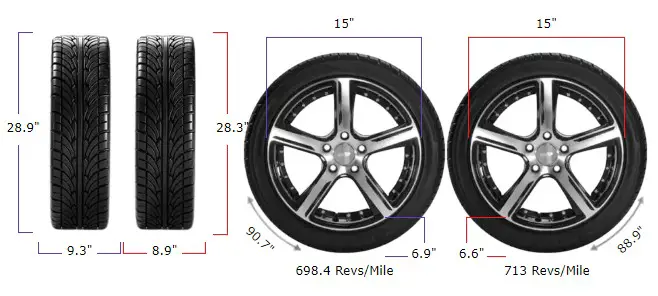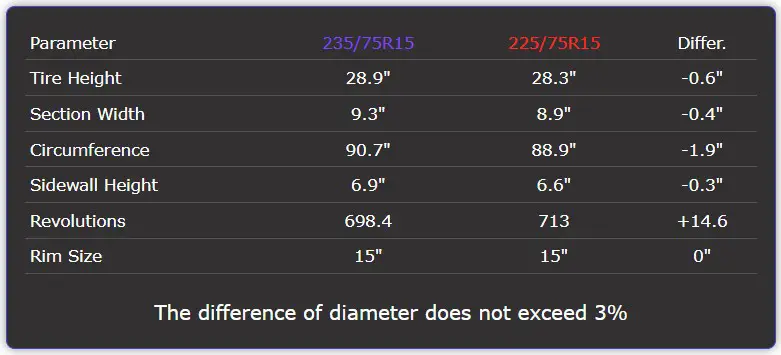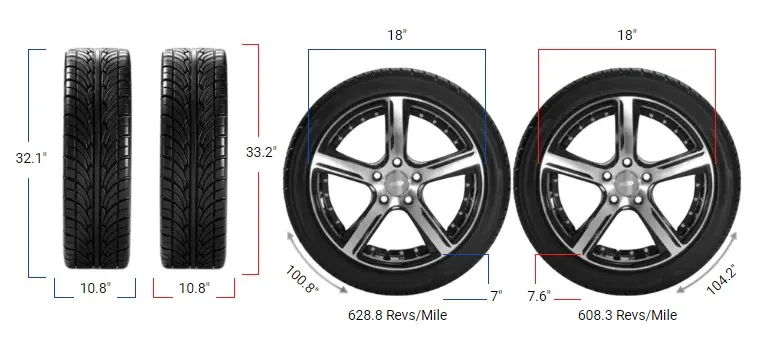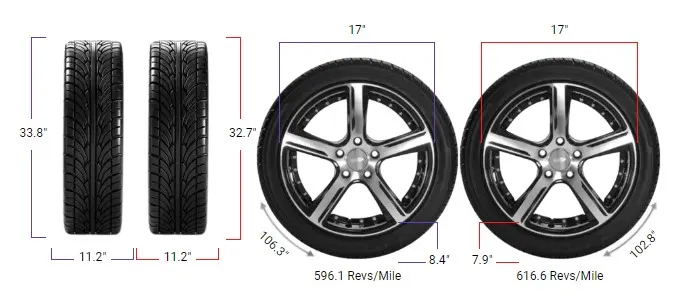Tire Size 235/75r15 vs 225/75r15

Are you considering downsizing from 235/75R15 to 225/75R15 tires? Discover the key differences and how they impact your vehicle’s performance, both on and off the road.
- Potential minor improvement in fuel efficiency
- Potentially firmer ride compared to 235/75R15 tires
- Minimal impact on ground clearance and off-road performance
- Feasible switch within acceptable tire size change limits

Fitment Guide
It’s crucial to ensure the new size is within 3% of the original tire’s overall diameter. In this case, the 225/75R15 has a diameter that is 2% smaller than the 235/75R15, which falls within the acceptable range.
This means that switching from 235/75R15 to 225/75R15 should not cause any major fitment issues.
On-Road Impact
Switching to a slightly narrower tire like the 225/75R15 can have some effects on your vehicle’s on-road performance. Here are a few potential changes you might notice:

- Ride Comfort: The narrower tire may provide a slightly firmer ride due to reduced sidewall flex.
- Fuel Efficiency: The 225/75R15 tire will have a marginally lower rolling resistance, which could lead to a minor improvement in gas mileage.
- Handling: The narrower tire may offer slightly more responsive steering, particularly during initial turn-in.
- Speedometer Accuracy: The 2% difference in diameter will cause your speedometer to read about 2% faster than your actual speed. Keep this in mind when monitoring your speed.
Off-Road Impact
If you use your vehicle for off-road adventures, here’s what you might experience with the switch to 225/75R15 tires:
- Traction: The narrower tire may provide slightly less traction in loose terrain like mud or sand due to the reduced contact patch.
- Ground Clearance: The 0.59-inch (15 mm) reduction in overall diameter will slightly decrease your vehicle’s ground clearance, but this difference is generally negligible for most off-road situations.
- Sidewall Strength: The narrower tire will have a slightly shorter sidewall, which may marginally reduce the tire’s ability to absorb impacts from rocks or other obstacles.

What is the Main Difference Between 235/75r15 and 225/75r15?
The primary difference between 235/75R15 and 225/75R15 tires lies in their width. A 235/75R15 tire is 0.39 inches (10 mm) wider than a 225/75R15 tire.
Can I Use 225/75r15 Instead of 235/75r15?
Yes, you can use 225/75R15 tires in place of 235/75R15 tires because the difference in their overall diameters is within the acceptable range of 3%.
235/75r15 vs 225/75r15
| Feature | 235/75R15 | 225/75R15 | Difference |
|---|---|---|---|
| Diameter inches (mm) | 28.88 (733.5) | 28.29 (718.5) | -0.59 (-15) -2% |
| Width inches (mm) | 9.25 (235) | 8.86 (225) | -0.39 (-10) -4.3% |
| Circumference inches (mm) | 90.72 (2304.36) | 88.87 (2257.23) | -1.86 (-47.12) -2% |
| Sidewall Height inches (mm) | 6.94 (176.25) | 6.64 (168.75) | -0.3 (-7.5) -4.3% |
| Revolutions per mile (km) | 698.39 (433.96) | 712.97 (443.02) | 14.58 (9.06) +2.1% |
| Speedo Reading | 20 mph | 19.59 mph | -0.41 mph |
How Much Taller Is a 235/75r15 Tire Than a 225/75r15?
A 235/75R15 tire is 0.59 inches (15 mm) taller than a 225/75R15 tire, based on the provided tire size comparison data.
How Much Wider is a 235/75r15 Tire Than a 225/75r15?
According to the given information, a 235/75R15 tire is 0.39 inches (10 mm) wider than a 225/75R15 tire.
Our Observation
After analyzing the differences between 235/75R15 and 225/75R15 tires, we believe that switching to the narrower size is a viable option for most vehicles.
The 2% difference in diameter and 4.3% difference in width are within acceptable ranges and should not significantly impact your vehicle’s performance or safety.
However, it’s essential to consider your specific driving needs and preferences. If you frequently drive in challenging off-road conditions or prioritize maximum traction and sidewall strength, sticking with the original 235/75R15 size might be the better choice.
Conversely, if you’re looking for a slightly firmer ride and potentially improved fuel efficiency, the 225/75R15 could be a suitable alternative.
Ultimately, the decision to switch tire sizes should be based on your individual requirements and your vehicle’s specifications. Always consult with a trusted tire professional to ensure proper fitment and compatibility before making any changes to your vehicle’s tire setup.



